Lean Six Sigma Implementation and Impact
VerifiedAdded on 2020/04/07
|20
|3979
|72
AI Summary
This assignment delves into the realm of Lean Six Sigma implementation and its multifaceted impacts across diverse sectors. It encourages a critical analysis of real-world case studies, examining how organizations leverage Lean Six Sigma principles to enhance operational efficiency, minimize waste, and ultimately improve customer satisfaction. The analysis encompasses research papers that shed light on the effectiveness of Lean Six Sigma methodologies in driving continuous improvement within manufacturing, service, and other industries.
Contribute Materials
Your contribution can guide someone’s learning journey. Share your
documents today.

PM
PROJECT MANAGEMENT METHODOLOGIES
PROJECT MANAGEMENT METHODOLOGIES
Secure Best Marks with AI Grader
Need help grading? Try our AI Grader for instant feedback on your assignments.
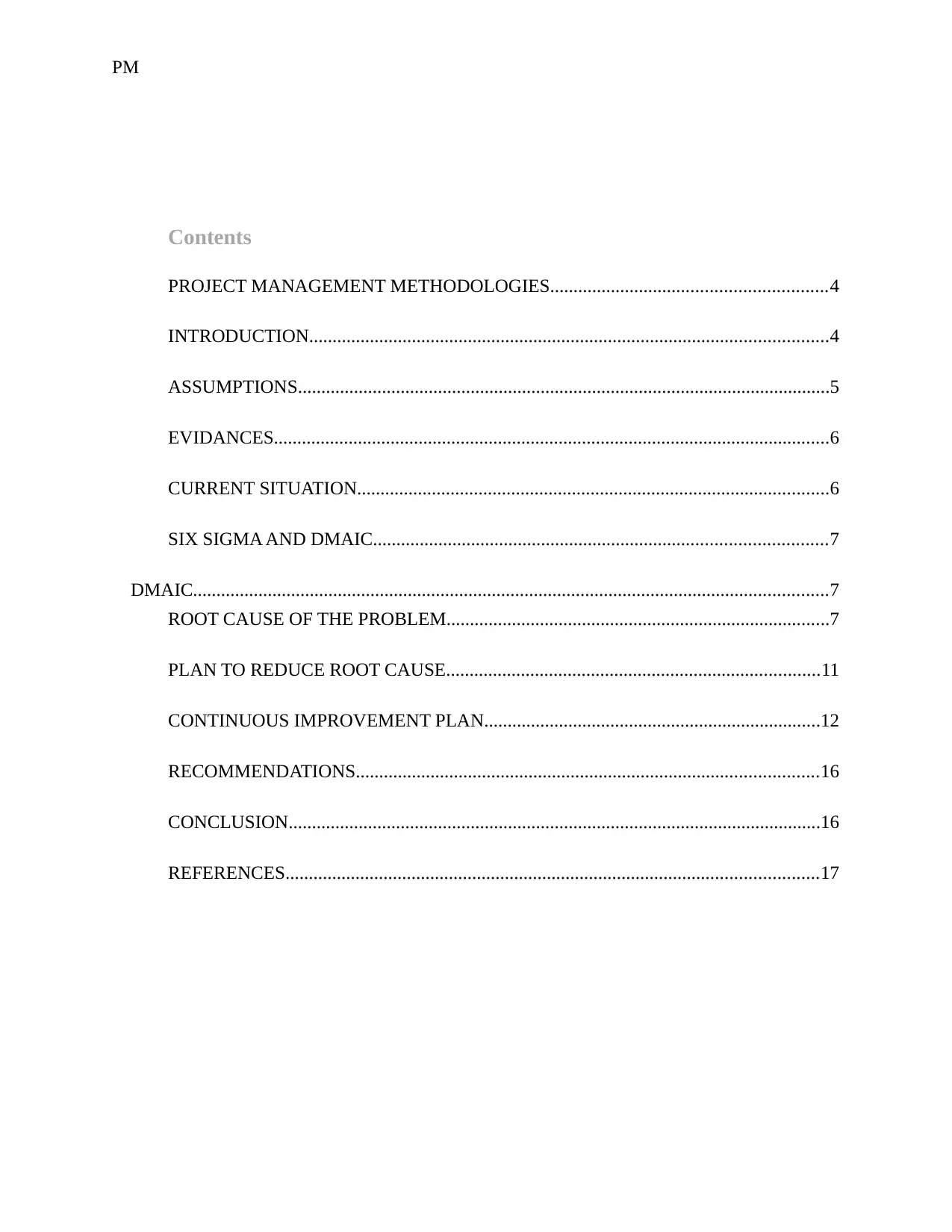
PM
Contents
PROJECT MANAGEMENT METHODOLOGIES...........................................................4
INTRODUCTION...............................................................................................................4
ASSUMPTIONS..................................................................................................................5
EVIDANCES.......................................................................................................................6
CURRENT SITUATION.....................................................................................................6
SIX SIGMA AND DMAIC.................................................................................................7
DMAIC........................................................................................................................................7
ROOT CAUSE OF THE PROBLEM..................................................................................7
PLAN TO REDUCE ROOT CAUSE................................................................................11
CONTINUOUS IMPROVEMENT PLAN........................................................................12
RECOMMENDATIONS...................................................................................................16
CONCLUSION..................................................................................................................16
REFERENCES..................................................................................................................17
Contents
PROJECT MANAGEMENT METHODOLOGIES...........................................................4
INTRODUCTION...............................................................................................................4
ASSUMPTIONS..................................................................................................................5
EVIDANCES.......................................................................................................................6
CURRENT SITUATION.....................................................................................................6
SIX SIGMA AND DMAIC.................................................................................................7
DMAIC........................................................................................................................................7
ROOT CAUSE OF THE PROBLEM..................................................................................7
PLAN TO REDUCE ROOT CAUSE................................................................................11
CONTINUOUS IMPROVEMENT PLAN........................................................................12
RECOMMENDATIONS...................................................................................................16
CONCLUSION..................................................................................................................16
REFERENCES..................................................................................................................17
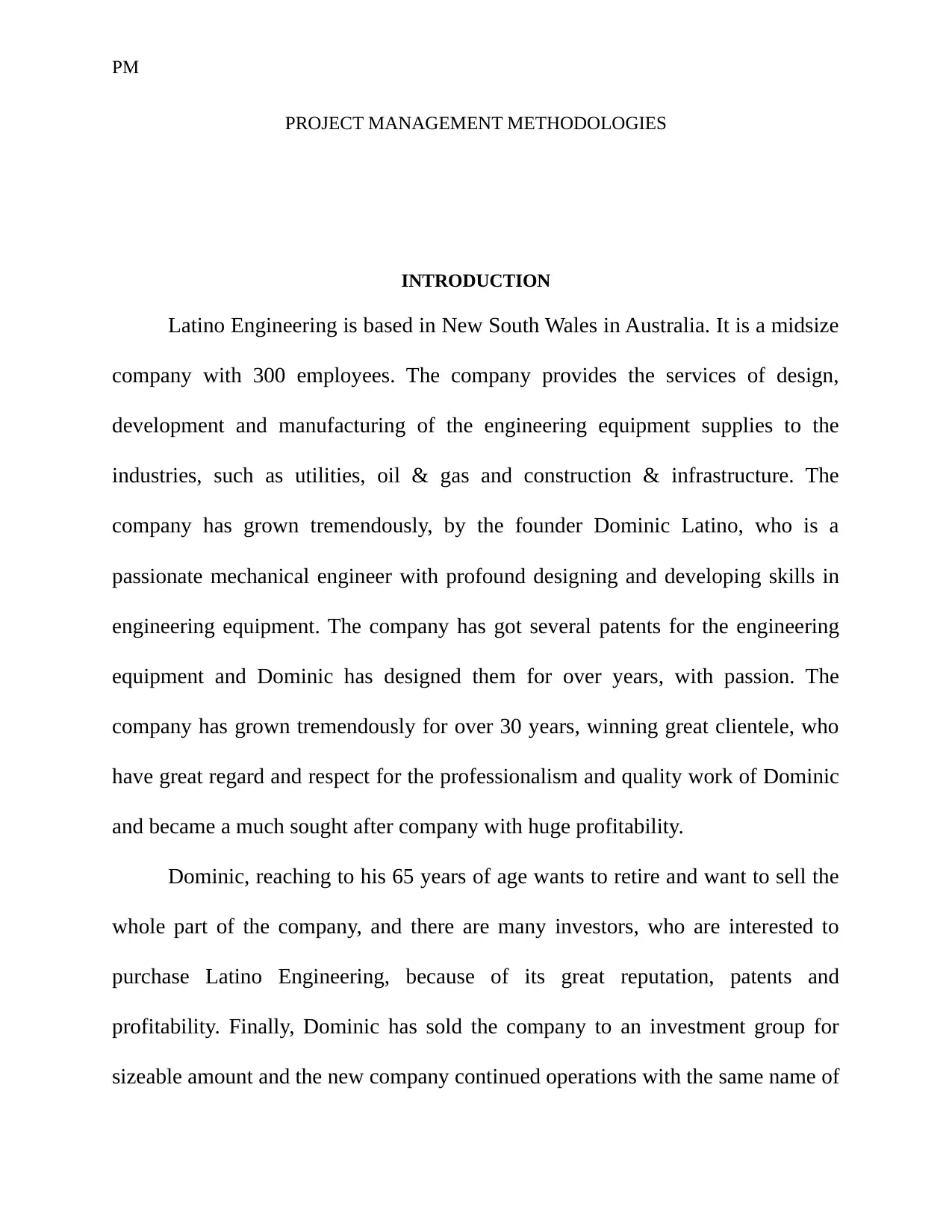
PM
PROJECT MANAGEMENT METHODOLOGIES
INTRODUCTION
Latino Engineering is based in New South Wales in Australia. It is a midsize
company with 300 employees. The company provides the services of design,
development and manufacturing of the engineering equipment supplies to the
industries, such as utilities, oil & gas and construction & infrastructure. The
company has grown tremendously, by the founder Dominic Latino, who is a
passionate mechanical engineer with profound designing and developing skills in
engineering equipment. The company has got several patents for the engineering
equipment and Dominic has designed them for over years, with passion. The
company has grown tremendously for over 30 years, winning great clientele, who
have great regard and respect for the professionalism and quality work of Dominic
and became a much sought after company with huge profitability.
Dominic, reaching to his 65 years of age wants to retire and want to sell the
whole part of the company, and there are many investors, who are interested to
purchase Latino Engineering, because of its great reputation, patents and
profitability. Finally, Dominic has sold the company to an investment group for
sizeable amount and the new company continued operations with the same name of
PROJECT MANAGEMENT METHODOLOGIES
INTRODUCTION
Latino Engineering is based in New South Wales in Australia. It is a midsize
company with 300 employees. The company provides the services of design,
development and manufacturing of the engineering equipment supplies to the
industries, such as utilities, oil & gas and construction & infrastructure. The
company has grown tremendously, by the founder Dominic Latino, who is a
passionate mechanical engineer with profound designing and developing skills in
engineering equipment. The company has got several patents for the engineering
equipment and Dominic has designed them for over years, with passion. The
company has grown tremendously for over 30 years, winning great clientele, who
have great regard and respect for the professionalism and quality work of Dominic
and became a much sought after company with huge profitability.
Dominic, reaching to his 65 years of age wants to retire and want to sell the
whole part of the company, and there are many investors, who are interested to
purchase Latino Engineering, because of its great reputation, patents and
profitability. Finally, Dominic has sold the company to an investment group for
sizeable amount and the new company continued operations with the same name of
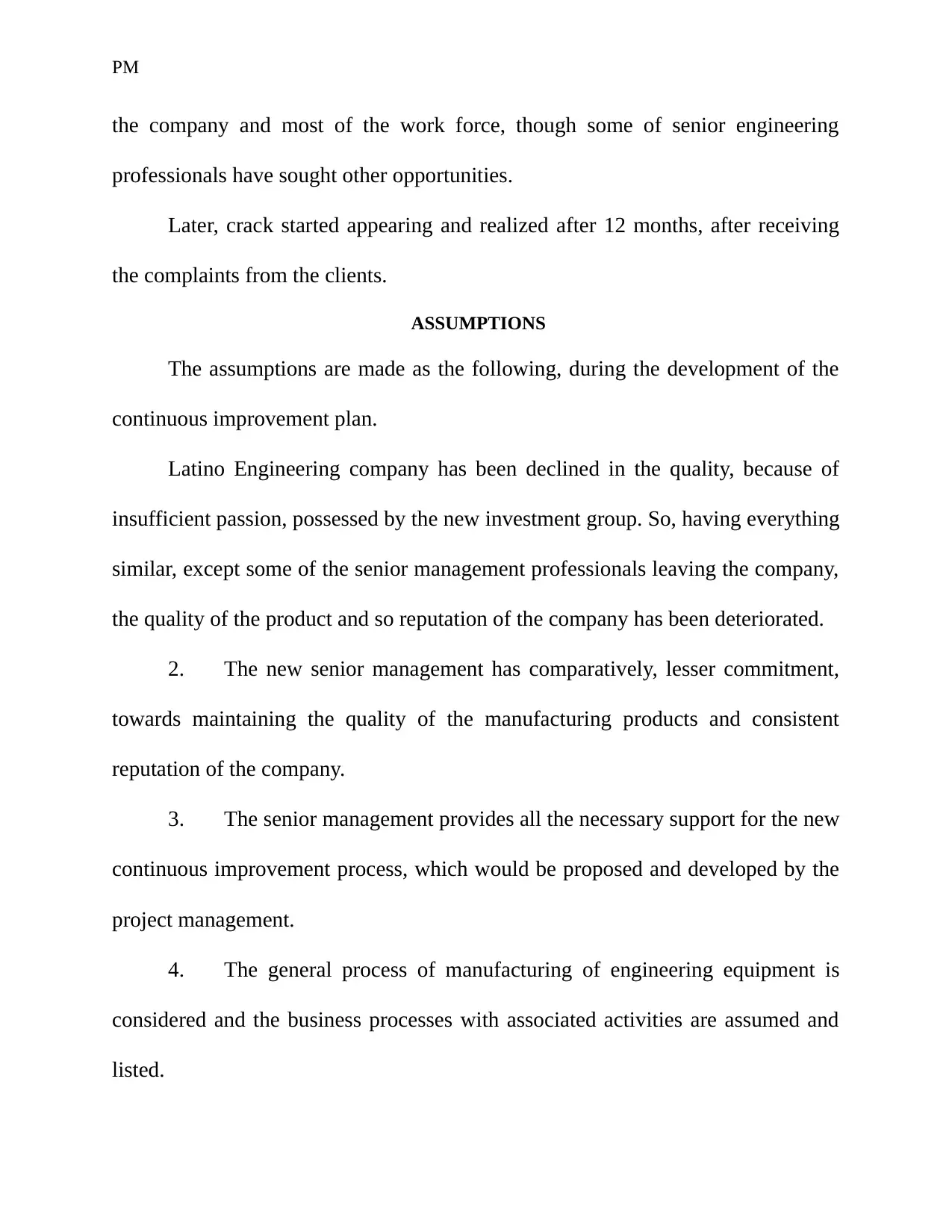
PM
the company and most of the work force, though some of senior engineering
professionals have sought other opportunities.
Later, crack started appearing and realized after 12 months, after receiving
the complaints from the clients.
ASSUMPTIONS
The assumptions are made as the following, during the development of the
continuous improvement plan.
Latino Engineering company has been declined in the quality, because of
insufficient passion, possessed by the new investment group. So, having everything
similar, except some of the senior management professionals leaving the company,
the quality of the product and so reputation of the company has been deteriorated.
2. The new senior management has comparatively, lesser commitment,
towards maintaining the quality of the manufacturing products and consistent
reputation of the company.
3. The senior management provides all the necessary support for the new
continuous improvement process, which would be proposed and developed by the
project management.
4. The general process of manufacturing of engineering equipment is
considered and the business processes with associated activities are assumed and
listed.
the company and most of the work force, though some of senior engineering
professionals have sought other opportunities.
Later, crack started appearing and realized after 12 months, after receiving
the complaints from the clients.
ASSUMPTIONS
The assumptions are made as the following, during the development of the
continuous improvement plan.
Latino Engineering company has been declined in the quality, because of
insufficient passion, possessed by the new investment group. So, having everything
similar, except some of the senior management professionals leaving the company,
the quality of the product and so reputation of the company has been deteriorated.
2. The new senior management has comparatively, lesser commitment,
towards maintaining the quality of the manufacturing products and consistent
reputation of the company.
3. The senior management provides all the necessary support for the new
continuous improvement process, which would be proposed and developed by the
project management.
4. The general process of manufacturing of engineering equipment is
considered and the business processes with associated activities are assumed and
listed.
Secure Best Marks with AI Grader
Need help grading? Try our AI Grader for instant feedback on your assignments.
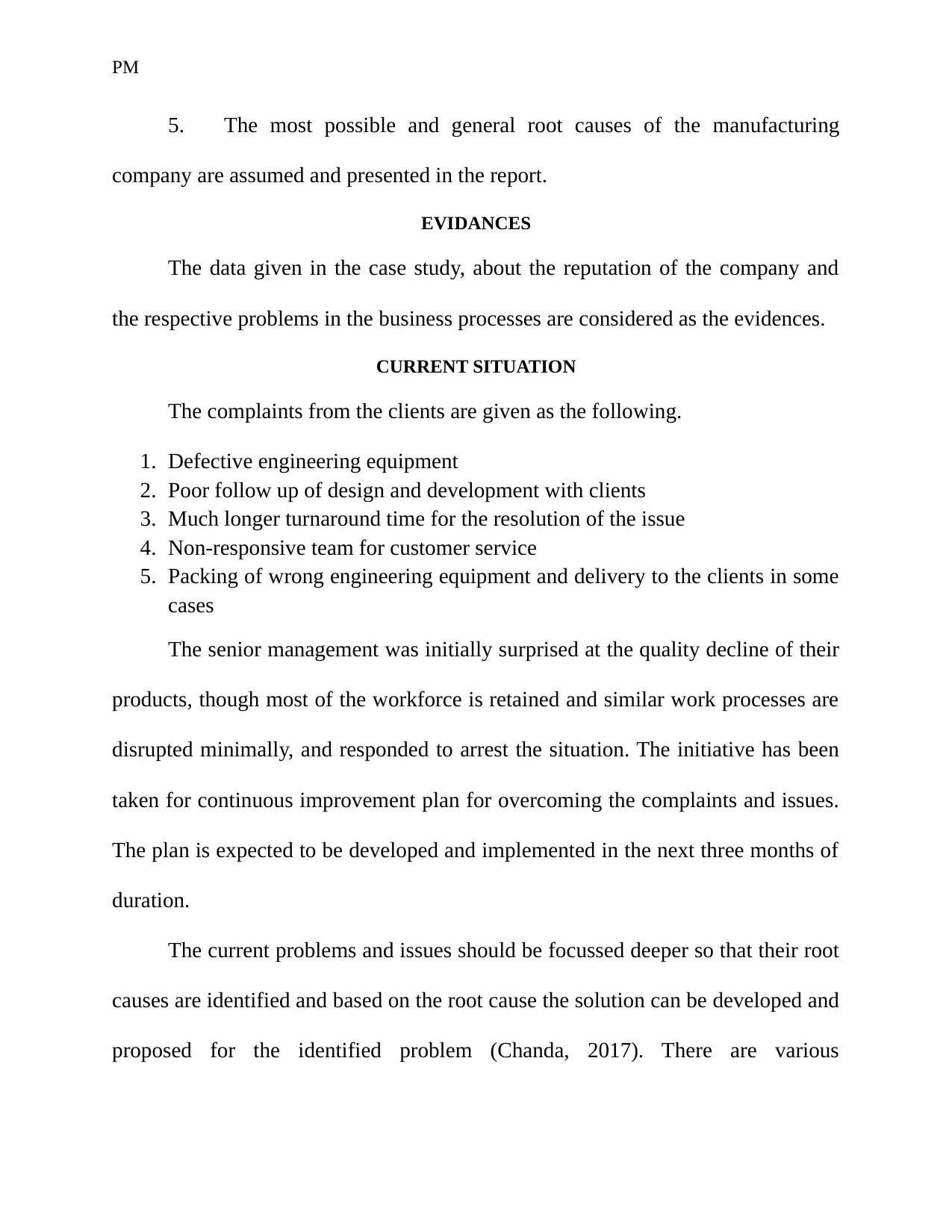
PM
5. The most possible and general root causes of the manufacturing
company are assumed and presented in the report.
EVIDANCES
The data given in the case study, about the reputation of the company and
the respective problems in the business processes are considered as the evidences.
CURRENT SITUATION
The complaints from the clients are given as the following.
1. Defective engineering equipment
2. Poor follow up of design and development with clients
3. Much longer turnaround time for the resolution of the issue
4. Non-responsive team for customer service
5. Packing of wrong engineering equipment and delivery to the clients in some
cases
The senior management was initially surprised at the quality decline of their
products, though most of the workforce is retained and similar work processes are
disrupted minimally, and responded to arrest the situation. The initiative has been
taken for continuous improvement plan for overcoming the complaints and issues.
The plan is expected to be developed and implemented in the next three months of
duration.
The current problems and issues should be focussed deeper so that their root
causes are identified and based on the root cause the solution can be developed and
proposed for the identified problem (Chanda, 2017). There are various
5. The most possible and general root causes of the manufacturing
company are assumed and presented in the report.
EVIDANCES
The data given in the case study, about the reputation of the company and
the respective problems in the business processes are considered as the evidences.
CURRENT SITUATION
The complaints from the clients are given as the following.
1. Defective engineering equipment
2. Poor follow up of design and development with clients
3. Much longer turnaround time for the resolution of the issue
4. Non-responsive team for customer service
5. Packing of wrong engineering equipment and delivery to the clients in some
cases
The senior management was initially surprised at the quality decline of their
products, though most of the workforce is retained and similar work processes are
disrupted minimally, and responded to arrest the situation. The initiative has been
taken for continuous improvement plan for overcoming the complaints and issues.
The plan is expected to be developed and implemented in the next three months of
duration.
The current problems and issues should be focussed deeper so that their root
causes are identified and based on the root cause the solution can be developed and
proposed for the identified problem (Chanda, 2017). There are various
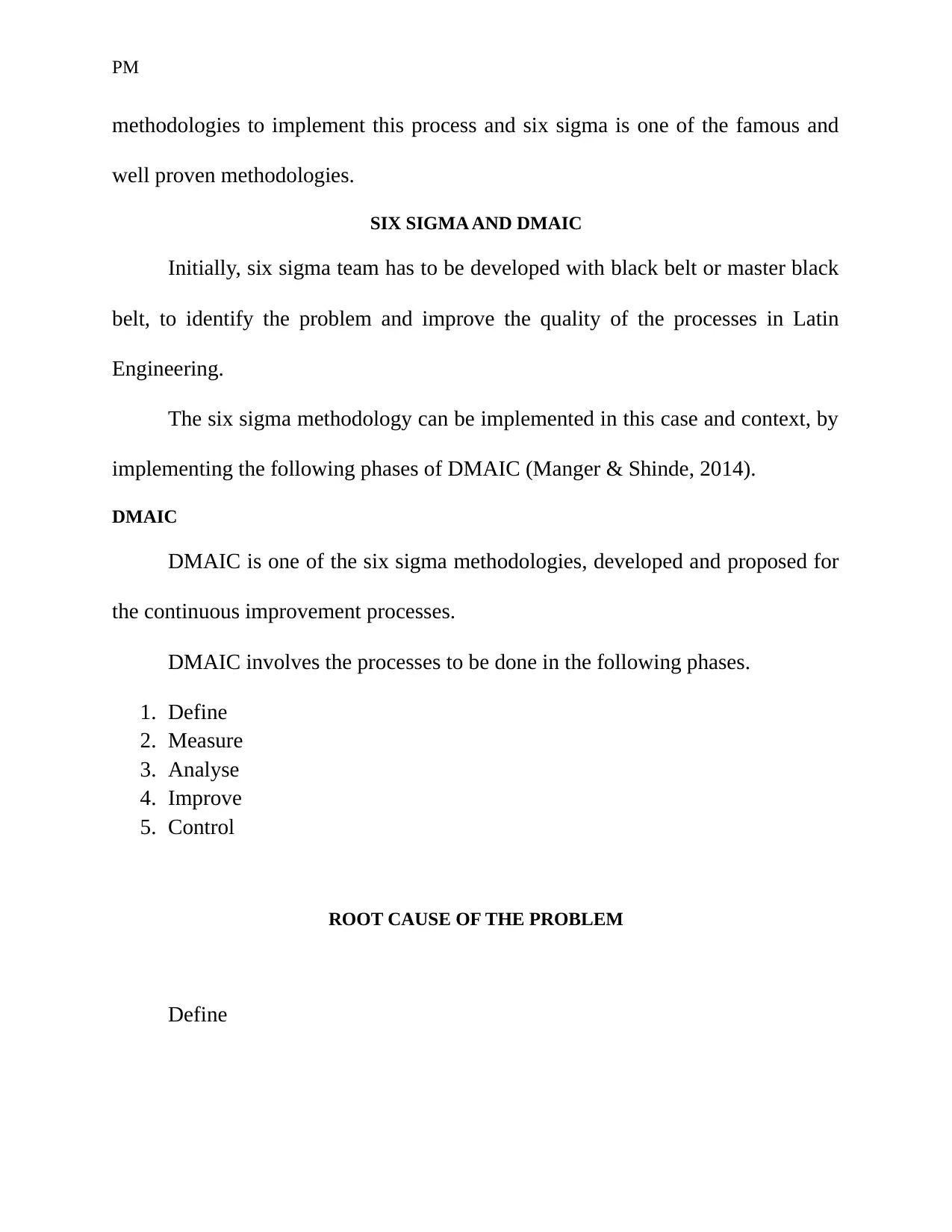
PM
methodologies to implement this process and six sigma is one of the famous and
well proven methodologies.
SIX SIGMA AND DMAIC
Initially, six sigma team has to be developed with black belt or master black
belt, to identify the problem and improve the quality of the processes in Latin
Engineering.
The six sigma methodology can be implemented in this case and context, by
implementing the following phases of DMAIC (Manger & Shinde, 2014).
DMAIC
DMAIC is one of the six sigma methodologies, developed and proposed for
the continuous improvement processes.
DMAIC involves the processes to be done in the following phases.
1. Define
2. Measure
3. Analyse
4. Improve
5. Control
ROOT CAUSE OF THE PROBLEM
Define
methodologies to implement this process and six sigma is one of the famous and
well proven methodologies.
SIX SIGMA AND DMAIC
Initially, six sigma team has to be developed with black belt or master black
belt, to identify the problem and improve the quality of the processes in Latin
Engineering.
The six sigma methodology can be implemented in this case and context, by
implementing the following phases of DMAIC (Manger & Shinde, 2014).
DMAIC
DMAIC is one of the six sigma methodologies, developed and proposed for
the continuous improvement processes.
DMAIC involves the processes to be done in the following phases.
1. Define
2. Measure
3. Analyse
4. Improve
5. Control
ROOT CAUSE OF THE PROBLEM
Define

PM
This is the key phase in applying the six sigma methodology, since when this phase
is done appropriately, the right root cause can be identified and the following
phases go in the appropriate ways, without any deviation. This phase helps
improving the goals of project and these goals are to be based on the needs and
wants of the customer.
In the context of the Latino engineering it is important to investigate and identify
the root cause of the dissatisfaction and complaints received by the customers.
In this context, feasible project scope has to be refined and the project goals are to
be set up and the root cause of the quality decline in manufacturing the engineering
equipment have to be discovered (Sokovic et al., 2009).
The complaints are,
- Defectiveness of product
- Poor design and development follow up with clients
- Longer turnaround time for issue resolution
- Wrong product delivery, some times
Based on the complaints found from the customers, it is understood that
there are quality issues in multiple departments, like in the basic design process,
based on the customer feedback, process of manufacturing, customer service and
sales departments. Since, these are the key departments that can influence the
overall performance and reputation of the company, the entire business processes
are to be developed, in terms of quality.
This is the key phase in applying the six sigma methodology, since when this phase
is done appropriately, the right root cause can be identified and the following
phases go in the appropriate ways, without any deviation. This phase helps
improving the goals of project and these goals are to be based on the needs and
wants of the customer.
In the context of the Latino engineering it is important to investigate and identify
the root cause of the dissatisfaction and complaints received by the customers.
In this context, feasible project scope has to be refined and the project goals are to
be set up and the root cause of the quality decline in manufacturing the engineering
equipment have to be discovered (Sokovic et al., 2009).
The complaints are,
- Defectiveness of product
- Poor design and development follow up with clients
- Longer turnaround time for issue resolution
- Wrong product delivery, some times
Based on the complaints found from the customers, it is understood that
there are quality issues in multiple departments, like in the basic design process,
based on the customer feedback, process of manufacturing, customer service and
sales departments. Since, these are the key departments that can influence the
overall performance and reputation of the company, the entire business processes
are to be developed, in terms of quality.
Paraphrase This Document
Need a fresh take? Get an instant paraphrase of this document with our AI Paraphraser

PM
In terms of design and development, mostly the previous work processes are
not disrupted and the company has to realize any product has to be developed, in
terms of changing the needs of the customers. So, apart from the complaints and
feedback received by the company, these concerns and suggestions are not
considered for the refinement of the engineering equipment. Customers complaints
are to be taken as opportunities to develop the product design and develop updated
engineering equipment.
The problem can be defined in this context is the quality decline the
following business processes.
1. Manufacturing process
2. Design and development process of product
3. Customer service process
4. Sales process
Though it is also possible to reengineer the product, based on the
requirements of the customers, it is basically important to refine the manufacturing
the processes. Identification and defining the problem involves the quality tool of
cause and effect diagram.
Measure
To find the deviation or decline of the quality, it is important to measure the
quality existing, in the present business. Quality measurement can be done by the
following critical success factors, measured. The process of measuring is done
In terms of design and development, mostly the previous work processes are
not disrupted and the company has to realize any product has to be developed, in
terms of changing the needs of the customers. So, apart from the complaints and
feedback received by the company, these concerns and suggestions are not
considered for the refinement of the engineering equipment. Customers complaints
are to be taken as opportunities to develop the product design and develop updated
engineering equipment.
The problem can be defined in this context is the quality decline the
following business processes.
1. Manufacturing process
2. Design and development process of product
3. Customer service process
4. Sales process
Though it is also possible to reengineer the product, based on the
requirements of the customers, it is basically important to refine the manufacturing
the processes. Identification and defining the problem involves the quality tool of
cause and effect diagram.
Measure
To find the deviation or decline of the quality, it is important to measure the
quality existing, in the present business. Quality measurement can be done by the
following critical success factors, measured. The process of measuring is done
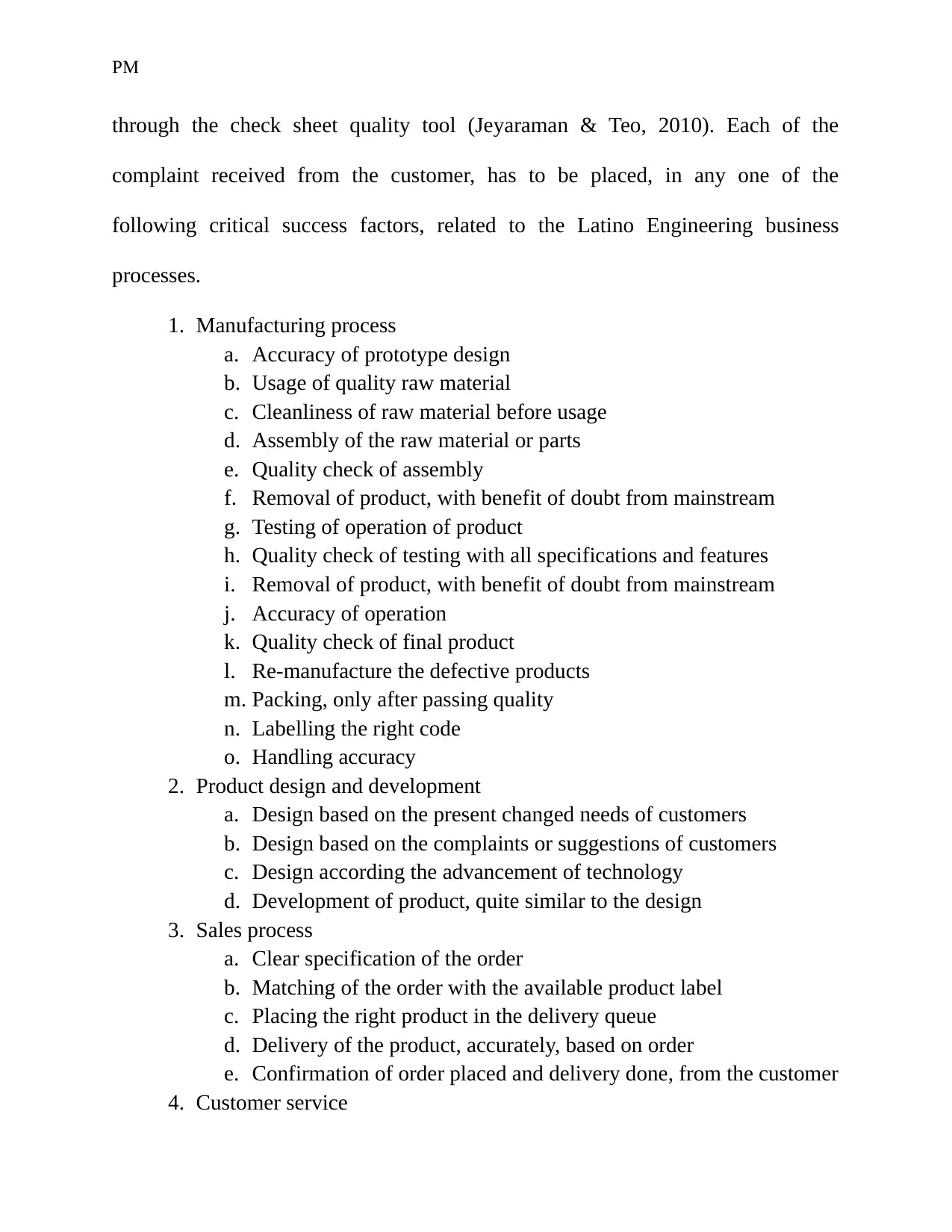
PM
through the check sheet quality tool (Jeyaraman & Teo, 2010). Each of the
complaint received from the customer, has to be placed, in any one of the
following critical success factors, related to the Latino Engineering business
processes.
1. Manufacturing process
a. Accuracy of prototype design
b. Usage of quality raw material
c. Cleanliness of raw material before usage
d. Assembly of the raw material or parts
e. Quality check of assembly
f. Removal of product, with benefit of doubt from mainstream
g. Testing of operation of product
h. Quality check of testing with all specifications and features
i. Removal of product, with benefit of doubt from mainstream
j. Accuracy of operation
k. Quality check of final product
l. Re-manufacture the defective products
m. Packing, only after passing quality
n. Labelling the right code
o. Handling accuracy
2. Product design and development
a. Design based on the present changed needs of customers
b. Design based on the complaints or suggestions of customers
c. Design according the advancement of technology
d. Development of product, quite similar to the design
3. Sales process
a. Clear specification of the order
b. Matching of the order with the available product label
c. Placing the right product in the delivery queue
d. Delivery of the product, accurately, based on order
e. Confirmation of order placed and delivery done, from the customer
4. Customer service
through the check sheet quality tool (Jeyaraman & Teo, 2010). Each of the
complaint received from the customer, has to be placed, in any one of the
following critical success factors, related to the Latino Engineering business
processes.
1. Manufacturing process
a. Accuracy of prototype design
b. Usage of quality raw material
c. Cleanliness of raw material before usage
d. Assembly of the raw material or parts
e. Quality check of assembly
f. Removal of product, with benefit of doubt from mainstream
g. Testing of operation of product
h. Quality check of testing with all specifications and features
i. Removal of product, with benefit of doubt from mainstream
j. Accuracy of operation
k. Quality check of final product
l. Re-manufacture the defective products
m. Packing, only after passing quality
n. Labelling the right code
o. Handling accuracy
2. Product design and development
a. Design based on the present changed needs of customers
b. Design based on the complaints or suggestions of customers
c. Design according the advancement of technology
d. Development of product, quite similar to the design
3. Sales process
a. Clear specification of the order
b. Matching of the order with the available product label
c. Placing the right product in the delivery queue
d. Delivery of the product, accurately, based on order
e. Confirmation of order placed and delivery done, from the customer
4. Customer service

PM
a. Prompt response from the CS executive
b. Accountability of the CS executive
c. Longer turnaround time for CS response
d. Follow up till issue resolution
Now, it is important to find the competitive leverages, by identifying the
most important critical success factors. This is an important phase again, since,
each and every complaint from the customer has to be categorized in each of the
categories, mentioned above. Then the final score has to be considered for the
following phase of analysis (Sunder, 2016).
PLAN TO REDUCE ROOT CAUSE
Analyze
Analysis has to be done, based on the resulted statistics after performing the
previous phase called, Measure. The analysis of the process has to be done, by
considering the scores obtained. The category or each of the critical success factors
of Latino Engineering has to be compared among them and all these CSFs have to
be ordered, in descending order. After analysing all the CSFs, the highest scored
CSF has to be considered and followed. The analysis phase has to be realized with
the cause and effect diagram.
The analysis process is performed for identifying, validating and selecting the root
cause. After the analysis, the root cause has to be listed based on descending order
a. Prompt response from the CS executive
b. Accountability of the CS executive
c. Longer turnaround time for CS response
d. Follow up till issue resolution
Now, it is important to find the competitive leverages, by identifying the
most important critical success factors. This is an important phase again, since,
each and every complaint from the customer has to be categorized in each of the
categories, mentioned above. Then the final score has to be considered for the
following phase of analysis (Sunder, 2016).
PLAN TO REDUCE ROOT CAUSE
Analyze
Analysis has to be done, based on the resulted statistics after performing the
previous phase called, Measure. The analysis of the process has to be done, by
considering the scores obtained. The category or each of the critical success factors
of Latino Engineering has to be compared among them and all these CSFs have to
be ordered, in descending order. After analysing all the CSFs, the highest scored
CSF has to be considered and followed. The analysis phase has to be realized with
the cause and effect diagram.
The analysis process is performed for identifying, validating and selecting the root
cause. After the analysis, the root cause has to be listed based on descending order
Secure Best Marks with AI Grader
Need help grading? Try our AI Grader for instant feedback on your assignments.
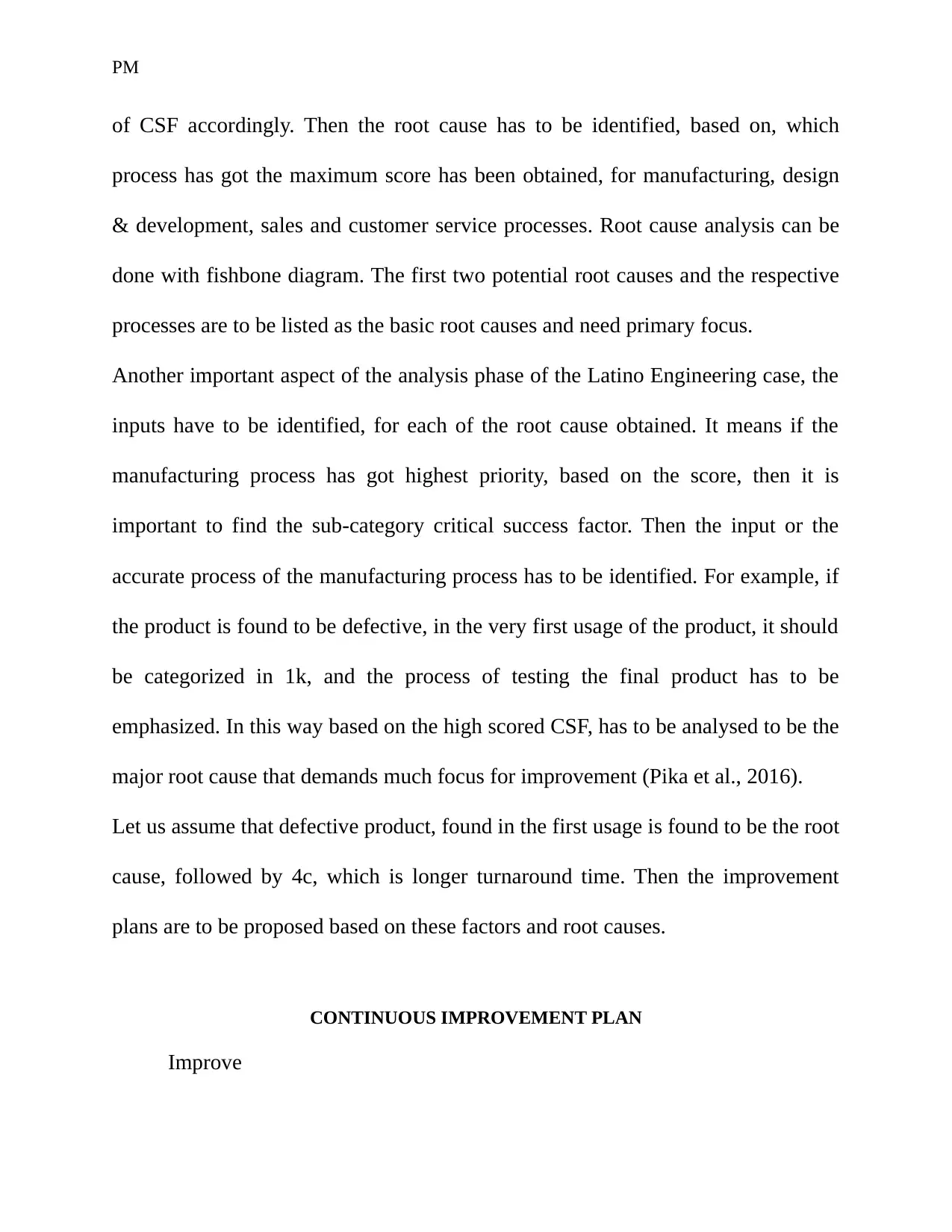
PM
of CSF accordingly. Then the root cause has to be identified, based on, which
process has got the maximum score has been obtained, for manufacturing, design
& development, sales and customer service processes. Root cause analysis can be
done with fishbone diagram. The first two potential root causes and the respective
processes are to be listed as the basic root causes and need primary focus.
Another important aspect of the analysis phase of the Latino Engineering case, the
inputs have to be identified, for each of the root cause obtained. It means if the
manufacturing process has got highest priority, based on the score, then it is
important to find the sub-category critical success factor. Then the input or the
accurate process of the manufacturing process has to be identified. For example, if
the product is found to be defective, in the very first usage of the product, it should
be categorized in 1k, and the process of testing the final product has to be
emphasized. In this way based on the high scored CSF, has to be analysed to be the
major root cause that demands much focus for improvement (Pika et al., 2016).
Let us assume that defective product, found in the first usage is found to be the root
cause, followed by 4c, which is longer turnaround time. Then the improvement
plans are to be proposed based on these factors and root causes.
CONTINUOUS IMPROVEMENT PLAN
Improve
of CSF accordingly. Then the root cause has to be identified, based on, which
process has got the maximum score has been obtained, for manufacturing, design
& development, sales and customer service processes. Root cause analysis can be
done with fishbone diagram. The first two potential root causes and the respective
processes are to be listed as the basic root causes and need primary focus.
Another important aspect of the analysis phase of the Latino Engineering case, the
inputs have to be identified, for each of the root cause obtained. It means if the
manufacturing process has got highest priority, based on the score, then it is
important to find the sub-category critical success factor. Then the input or the
accurate process of the manufacturing process has to be identified. For example, if
the product is found to be defective, in the very first usage of the product, it should
be categorized in 1k, and the process of testing the final product has to be
emphasized. In this way based on the high scored CSF, has to be analysed to be the
major root cause that demands much focus for improvement (Pika et al., 2016).
Let us assume that defective product, found in the first usage is found to be the root
cause, followed by 4c, which is longer turnaround time. Then the improvement
plans are to be proposed based on these factors and root causes.
CONTINUOUS IMPROVEMENT PLAN
Improve
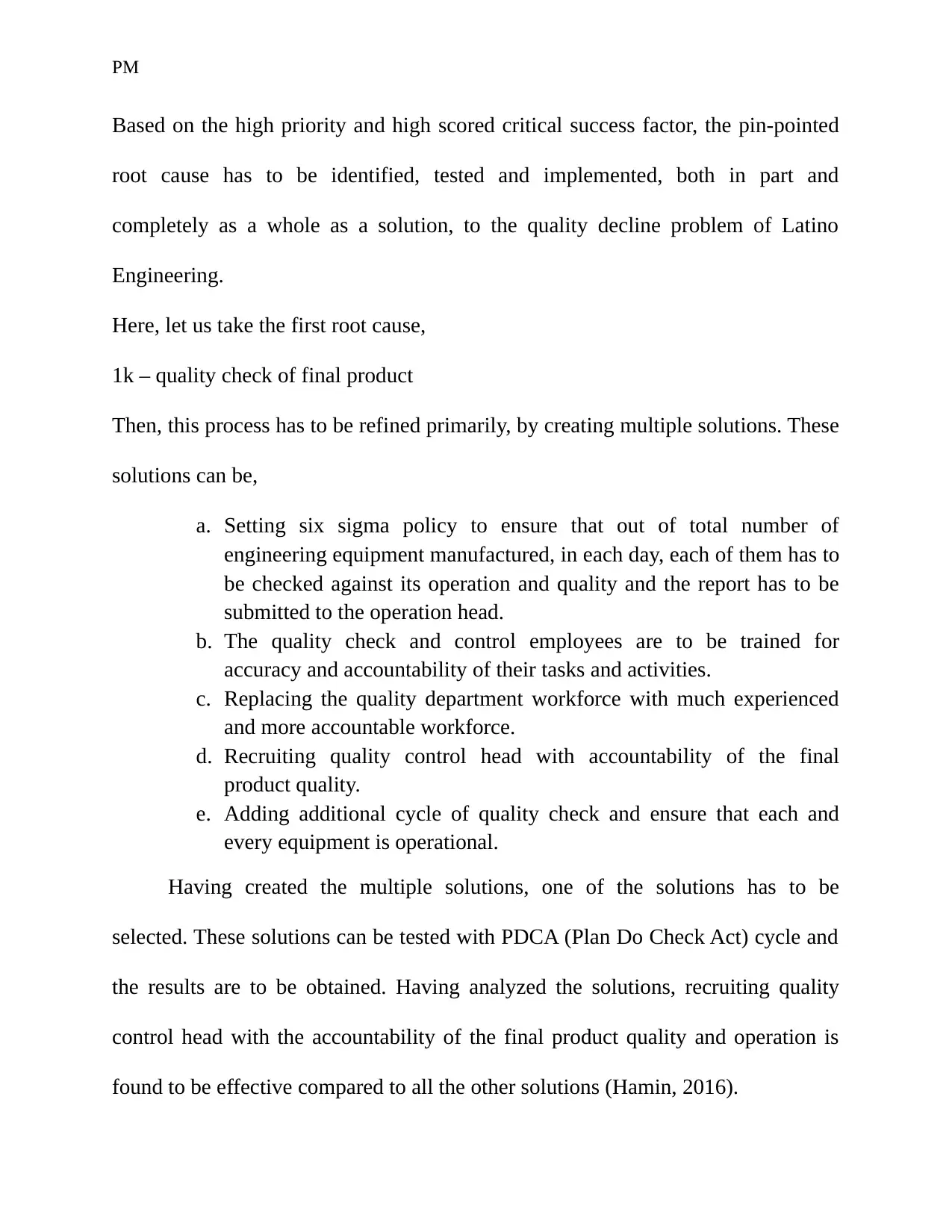
PM
Based on the high priority and high scored critical success factor, the pin-pointed
root cause has to be identified, tested and implemented, both in part and
completely as a whole as a solution, to the quality decline problem of Latino
Engineering.
Here, let us take the first root cause,
1k – quality check of final product
Then, this process has to be refined primarily, by creating multiple solutions. These
solutions can be,
a. Setting six sigma policy to ensure that out of total number of
engineering equipment manufactured, in each day, each of them has to
be checked against its operation and quality and the report has to be
submitted to the operation head.
b. The quality check and control employees are to be trained for
accuracy and accountability of their tasks and activities.
c. Replacing the quality department workforce with much experienced
and more accountable workforce.
d. Recruiting quality control head with accountability of the final
product quality.
e. Adding additional cycle of quality check and ensure that each and
every equipment is operational.
Having created the multiple solutions, one of the solutions has to be
selected. These solutions can be tested with PDCA (Plan Do Check Act) cycle and
the results are to be obtained. Having analyzed the solutions, recruiting quality
control head with the accountability of the final product quality and operation is
found to be effective compared to all the other solutions (Hamin, 2016).
Based on the high priority and high scored critical success factor, the pin-pointed
root cause has to be identified, tested and implemented, both in part and
completely as a whole as a solution, to the quality decline problem of Latino
Engineering.
Here, let us take the first root cause,
1k – quality check of final product
Then, this process has to be refined primarily, by creating multiple solutions. These
solutions can be,
a. Setting six sigma policy to ensure that out of total number of
engineering equipment manufactured, in each day, each of them has to
be checked against its operation and quality and the report has to be
submitted to the operation head.
b. The quality check and control employees are to be trained for
accuracy and accountability of their tasks and activities.
c. Replacing the quality department workforce with much experienced
and more accountable workforce.
d. Recruiting quality control head with accountability of the final
product quality.
e. Adding additional cycle of quality check and ensure that each and
every equipment is operational.
Having created the multiple solutions, one of the solutions has to be
selected. These solutions can be tested with PDCA (Plan Do Check Act) cycle and
the results are to be obtained. Having analyzed the solutions, recruiting quality
control head with the accountability of the final product quality and operation is
found to be effective compared to all the other solutions (Hamin, 2016).
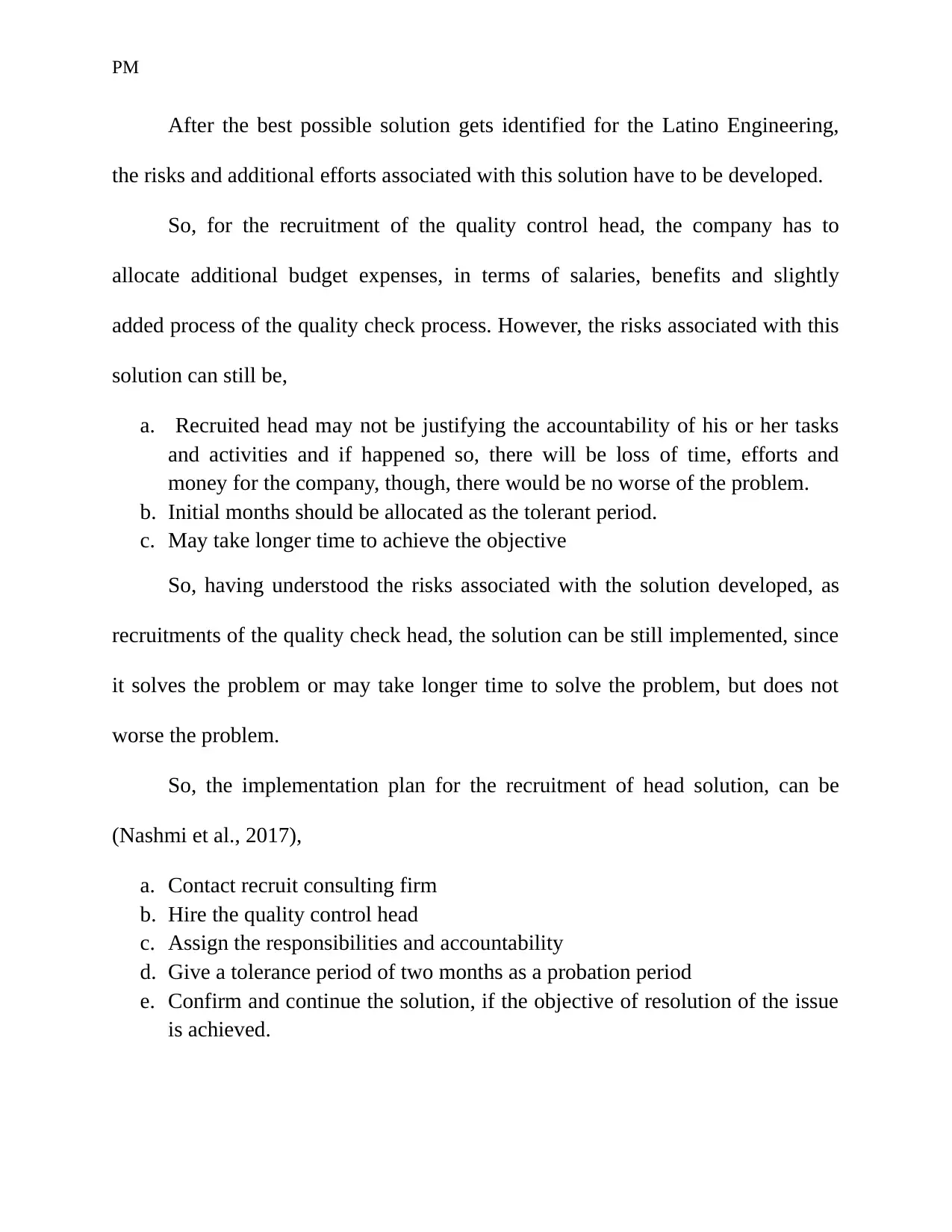
PM
After the best possible solution gets identified for the Latino Engineering,
the risks and additional efforts associated with this solution have to be developed.
So, for the recruitment of the quality control head, the company has to
allocate additional budget expenses, in terms of salaries, benefits and slightly
added process of the quality check process. However, the risks associated with this
solution can still be,
a. Recruited head may not be justifying the accountability of his or her tasks
and activities and if happened so, there will be loss of time, efforts and
money for the company, though, there would be no worse of the problem.
b. Initial months should be allocated as the tolerant period.
c. May take longer time to achieve the objective
So, having understood the risks associated with the solution developed, as
recruitments of the quality check head, the solution can be still implemented, since
it solves the problem or may take longer time to solve the problem, but does not
worse the problem.
So, the implementation plan for the recruitment of head solution, can be
(Nashmi et al., 2017),
a. Contact recruit consulting firm
b. Hire the quality control head
c. Assign the responsibilities and accountability
d. Give a tolerance period of two months as a probation period
e. Confirm and continue the solution, if the objective of resolution of the issue
is achieved.
After the best possible solution gets identified for the Latino Engineering,
the risks and additional efforts associated with this solution have to be developed.
So, for the recruitment of the quality control head, the company has to
allocate additional budget expenses, in terms of salaries, benefits and slightly
added process of the quality check process. However, the risks associated with this
solution can still be,
a. Recruited head may not be justifying the accountability of his or her tasks
and activities and if happened so, there will be loss of time, efforts and
money for the company, though, there would be no worse of the problem.
b. Initial months should be allocated as the tolerant period.
c. May take longer time to achieve the objective
So, having understood the risks associated with the solution developed, as
recruitments of the quality check head, the solution can be still implemented, since
it solves the problem or may take longer time to solve the problem, but does not
worse the problem.
So, the implementation plan for the recruitment of head solution, can be
(Nashmi et al., 2017),
a. Contact recruit consulting firm
b. Hire the quality control head
c. Assign the responsibilities and accountability
d. Give a tolerance period of two months as a probation period
e. Confirm and continue the solution, if the objective of resolution of the issue
is achieved.
Paraphrase This Document
Need a fresh take? Get an instant paraphrase of this document with our AI Paraphraser

PM
Control
The final phase of the DMAIC for the continuous improvement plan is to
control. The improvement plan has to be standardized with the control phase. The
control phase consists of standardization process that should be consistently
monitored and recorded to ensure that the results are obtained and objectives are
achieved.
For standardizing the process of continuous improvement plan, by considering
one critical success factor of final quality check process and the solution of
recruiting the head, a control chart has to be developed and implemented on
regular, in fact on daily basis.
A statistics of the total number of defects reported and complained by the
customer, in each day has to be recorded. A graph has to be drawn with the 30
days period in the X-axis and number of defects complained for the ordered
engineering equipment in each day. Ideally, the graph has to be grounded to zero,
though it would be over expectation. So, the graph should be declining each and
every day (Abraham, 2016). When the graph reaches to zero, on one day, the
same results are to be strived to be continued.
Control
The final phase of the DMAIC for the continuous improvement plan is to
control. The improvement plan has to be standardized with the control phase. The
control phase consists of standardization process that should be consistently
monitored and recorded to ensure that the results are obtained and objectives are
achieved.
For standardizing the process of continuous improvement plan, by considering
one critical success factor of final quality check process and the solution of
recruiting the head, a control chart has to be developed and implemented on
regular, in fact on daily basis.
A statistics of the total number of defects reported and complained by the
customer, in each day has to be recorded. A graph has to be drawn with the 30
days period in the X-axis and number of defects complained for the ordered
engineering equipment in each day. Ideally, the graph has to be grounded to zero,
though it would be over expectation. So, the graph should be declining each and
every day (Abraham, 2016). When the graph reaches to zero, on one day, the
same results are to be strived to be continued.
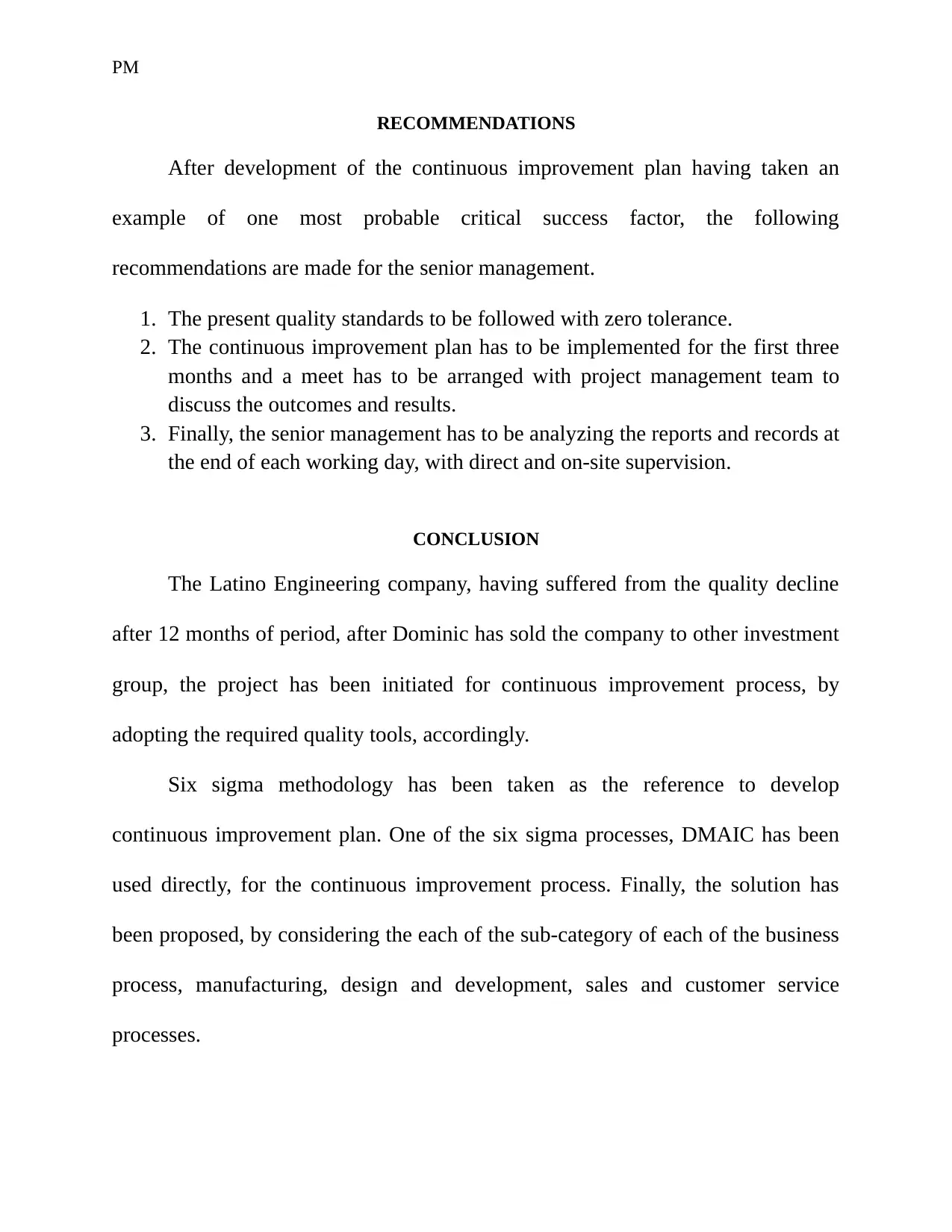
PM
RECOMMENDATIONS
After development of the continuous improvement plan having taken an
example of one most probable critical success factor, the following
recommendations are made for the senior management.
1. The present quality standards to be followed with zero tolerance.
2. The continuous improvement plan has to be implemented for the first three
months and a meet has to be arranged with project management team to
discuss the outcomes and results.
3. Finally, the senior management has to be analyzing the reports and records at
the end of each working day, with direct and on-site supervision.
CONCLUSION
The Latino Engineering company, having suffered from the quality decline
after 12 months of period, after Dominic has sold the company to other investment
group, the project has been initiated for continuous improvement process, by
adopting the required quality tools, accordingly.
Six sigma methodology has been taken as the reference to develop
continuous improvement plan. One of the six sigma processes, DMAIC has been
used directly, for the continuous improvement process. Finally, the solution has
been proposed, by considering the each of the sub-category of each of the business
process, manufacturing, design and development, sales and customer service
processes.
RECOMMENDATIONS
After development of the continuous improvement plan having taken an
example of one most probable critical success factor, the following
recommendations are made for the senior management.
1. The present quality standards to be followed with zero tolerance.
2. The continuous improvement plan has to be implemented for the first three
months and a meet has to be arranged with project management team to
discuss the outcomes and results.
3. Finally, the senior management has to be analyzing the reports and records at
the end of each working day, with direct and on-site supervision.
CONCLUSION
The Latino Engineering company, having suffered from the quality decline
after 12 months of period, after Dominic has sold the company to other investment
group, the project has been initiated for continuous improvement process, by
adopting the required quality tools, accordingly.
Six sigma methodology has been taken as the reference to develop
continuous improvement plan. One of the six sigma processes, DMAIC has been
used directly, for the continuous improvement process. Finally, the solution has
been proposed, by considering the each of the sub-category of each of the business
process, manufacturing, design and development, sales and customer service
processes.
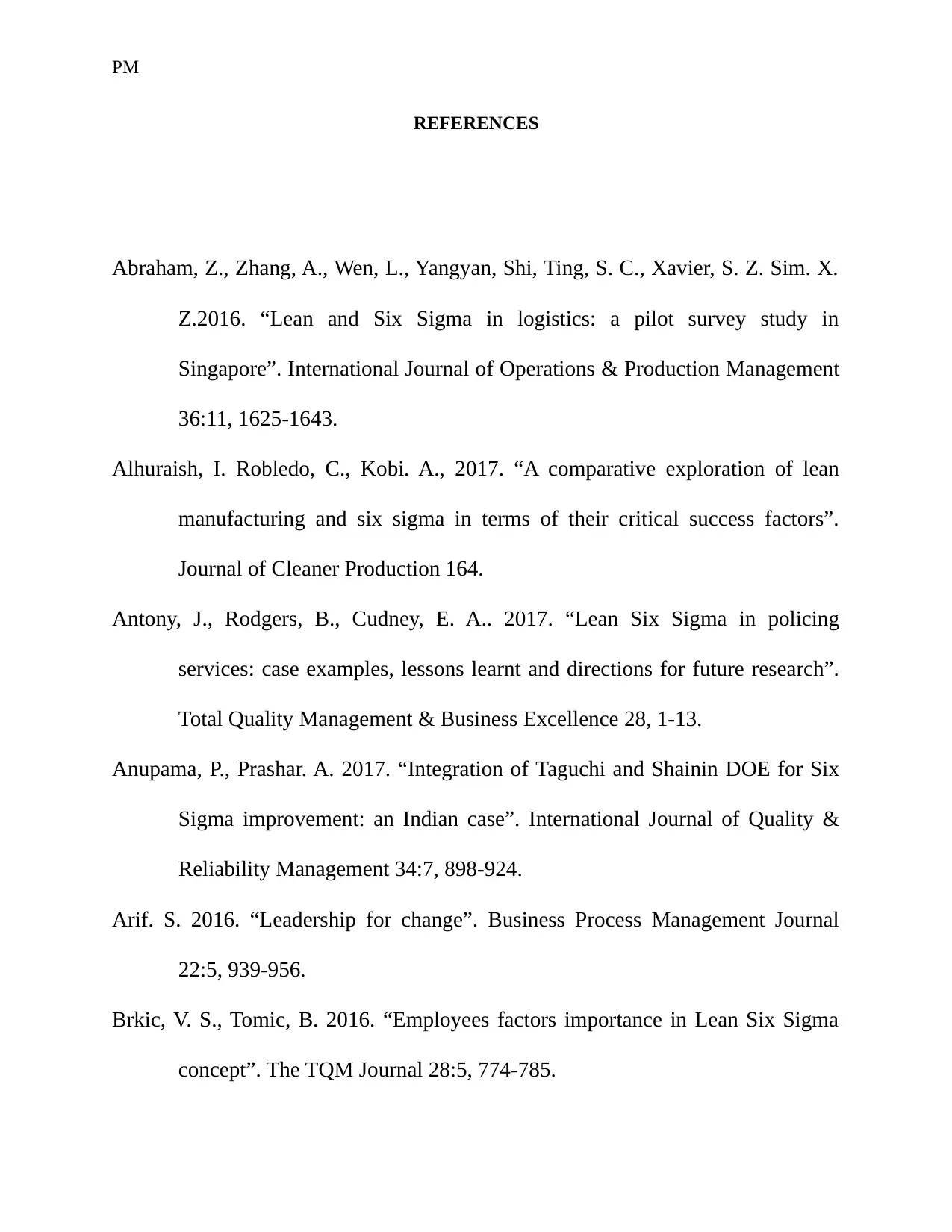
PM
REFERENCES
Abraham, Z., Zhang, A., Wen, L., Yangyan, Shi, Ting, S. C., Xavier, S. Z. Sim. X.
Z.2016. “Lean and Six Sigma in logistics: a pilot survey study in
Singapore”. International Journal of Operations & Production Management
36:11, 1625-1643.
Alhuraish, I. Robledo, C., Kobi. A., 2017. “A comparative exploration of lean
manufacturing and six sigma in terms of their critical success factors”.
Journal of Cleaner Production 164.
Antony, J., Rodgers, B., Cudney, E. A.. 2017. “Lean Six Sigma in policing
services: case examples, lessons learnt and directions for future research”.
Total Quality Management & Business Excellence 28, 1-13.
Anupama, P., Prashar. A. 2017. “Integration of Taguchi and Shainin DOE for Six
Sigma improvement: an Indian case”. International Journal of Quality &
Reliability Management 34:7, 898-924.
Arif. S. 2016. “Leadership for change”. Business Process Management Journal
22:5, 939-956.
Brkic, V. S., Tomic, B. 2016. “Employees factors importance in Lean Six Sigma
concept”. The TQM Journal 28:5, 774-785.
REFERENCES
Abraham, Z., Zhang, A., Wen, L., Yangyan, Shi, Ting, S. C., Xavier, S. Z. Sim. X.
Z.2016. “Lean and Six Sigma in logistics: a pilot survey study in
Singapore”. International Journal of Operations & Production Management
36:11, 1625-1643.
Alhuraish, I. Robledo, C., Kobi. A., 2017. “A comparative exploration of lean
manufacturing and six sigma in terms of their critical success factors”.
Journal of Cleaner Production 164.
Antony, J., Rodgers, B., Cudney, E. A.. 2017. “Lean Six Sigma in policing
services: case examples, lessons learnt and directions for future research”.
Total Quality Management & Business Excellence 28, 1-13.
Anupama, P., Prashar. A. 2017. “Integration of Taguchi and Shainin DOE for Six
Sigma improvement: an Indian case”. International Journal of Quality &
Reliability Management 34:7, 898-924.
Arif. S. 2016. “Leadership for change”. Business Process Management Journal
22:5, 939-956.
Brkic, V. S., Tomic, B. 2016. “Employees factors importance in Lean Six Sigma
concept”. The TQM Journal 28:5, 774-785.
Secure Best Marks with AI Grader
Need help grading? Try our AI Grader for instant feedback on your assignments.
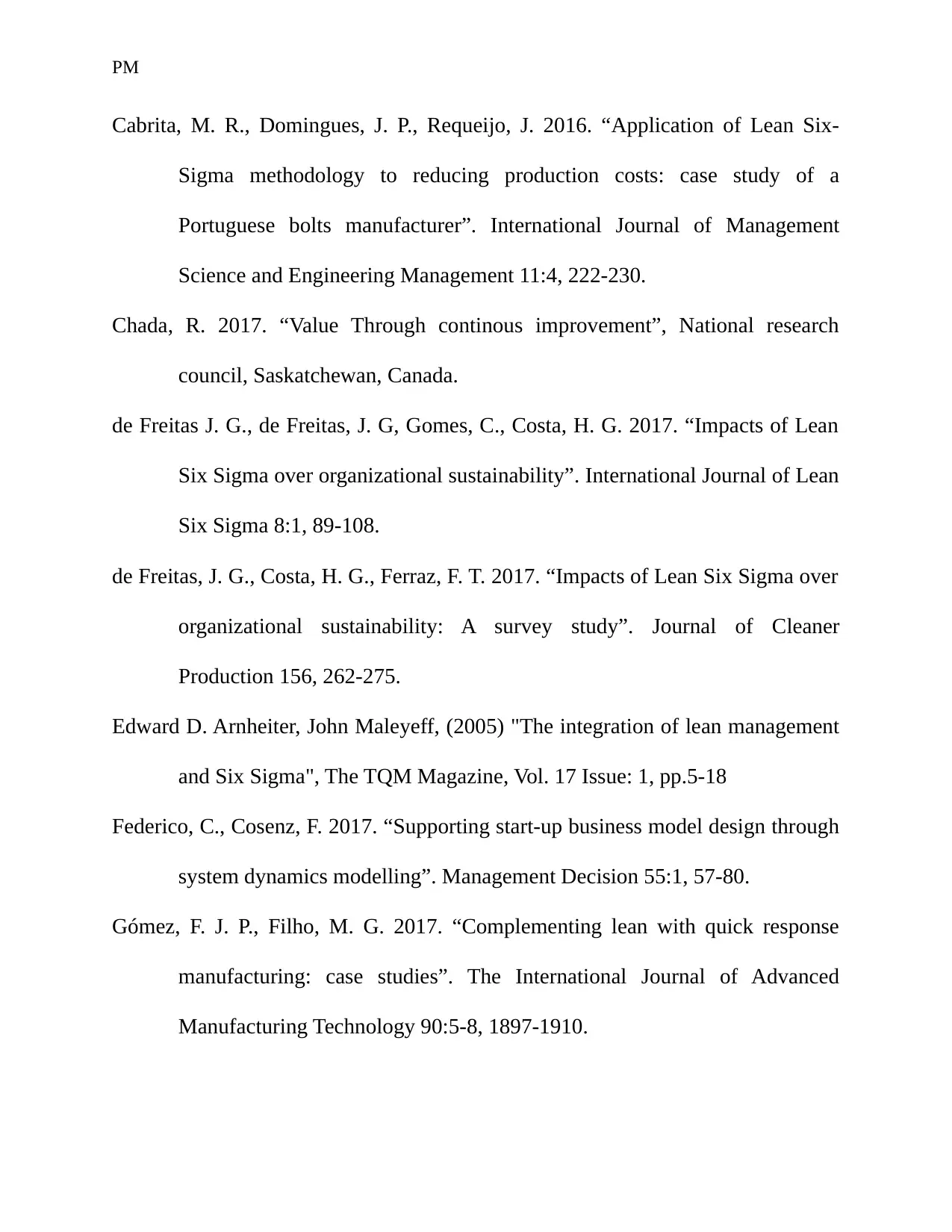
PM
Cabrita, M. R., Domingues, J. P., Requeijo, J. 2016. “Application of Lean Six-
Sigma methodology to reducing production costs: case study of a
Portuguese bolts manufacturer”. International Journal of Management
Science and Engineering Management 11:4, 222-230.
Chada, R. 2017. “Value Through continous improvement”, National research
council, Saskatchewan, Canada.
de Freitas J. G., de Freitas, J. G, Gomes, C., Costa, H. G. 2017. “Impacts of Lean
Six Sigma over organizational sustainability”. International Journal of Lean
Six Sigma 8:1, 89-108.
de Freitas, J. G., Costa, H. G., Ferraz, F. T. 2017. “Impacts of Lean Six Sigma over
organizational sustainability: A survey study”. Journal of Cleaner
Production 156, 262-275.
Edward D. Arnheiter, John Maleyeff, (2005) "The integration of lean management
and Six Sigma", The TQM Magazine, Vol. 17 Issue: 1, pp.5-18
Federico, C., Cosenz, F. 2017. “Supporting start-up business model design through
system dynamics modelling”. Management Decision 55:1, 57-80.
Gómez, F. J. P., Filho, M. G. 2017. “Complementing lean with quick response
manufacturing: case studies”. The International Journal of Advanced
Manufacturing Technology 90:5-8, 1897-1910.
Cabrita, M. R., Domingues, J. P., Requeijo, J. 2016. “Application of Lean Six-
Sigma methodology to reducing production costs: case study of a
Portuguese bolts manufacturer”. International Journal of Management
Science and Engineering Management 11:4, 222-230.
Chada, R. 2017. “Value Through continous improvement”, National research
council, Saskatchewan, Canada.
de Freitas J. G., de Freitas, J. G, Gomes, C., Costa, H. G. 2017. “Impacts of Lean
Six Sigma over organizational sustainability”. International Journal of Lean
Six Sigma 8:1, 89-108.
de Freitas, J. G., Costa, H. G., Ferraz, F. T. 2017. “Impacts of Lean Six Sigma over
organizational sustainability: A survey study”. Journal of Cleaner
Production 156, 262-275.
Edward D. Arnheiter, John Maleyeff, (2005) "The integration of lean management
and Six Sigma", The TQM Magazine, Vol. 17 Issue: 1, pp.5-18
Federico, C., Cosenz, F. 2017. “Supporting start-up business model design through
system dynamics modelling”. Management Decision 55:1, 57-80.
Gómez, F. J. P., Filho, M. G. 2017. “Complementing lean with quick response
manufacturing: case studies”. The International Journal of Advanced
Manufacturing Technology 90:5-8, 1897-1910.
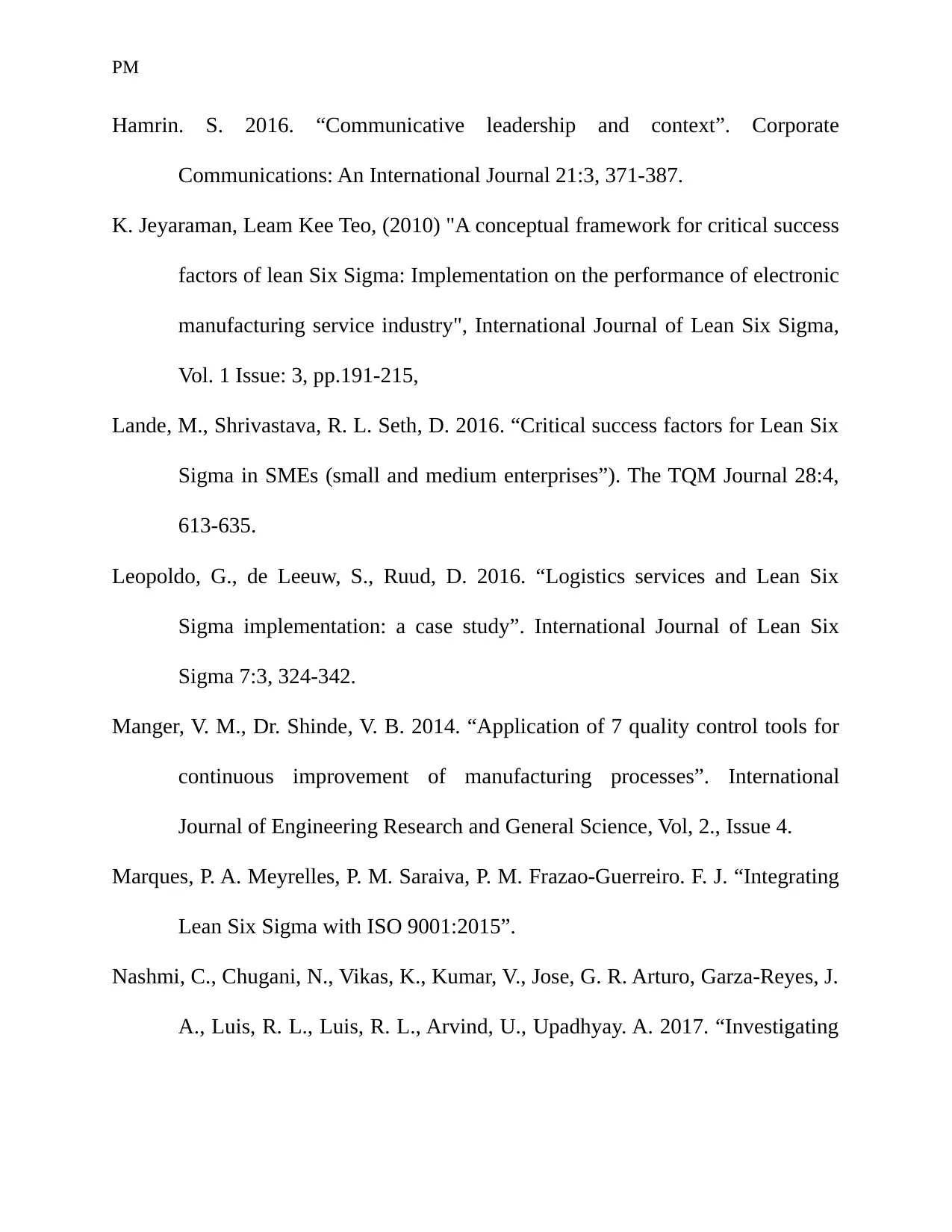
PM
Hamrin. S. 2016. “Communicative leadership and context”. Corporate
Communications: An International Journal 21:3, 371-387.
K. Jeyaraman, Leam Kee Teo, (2010) "A conceptual framework for critical success
factors of lean Six Sigma: Implementation on the performance of electronic
manufacturing service industry", International Journal of Lean Six Sigma,
Vol. 1 Issue: 3, pp.191-215,
Lande, M., Shrivastava, R. L. Seth, D. 2016. “Critical success factors for Lean Six
Sigma in SMEs (small and medium enterprises”). The TQM Journal 28:4,
613-635.
Leopoldo, G., de Leeuw, S., Ruud, D. 2016. “Logistics services and Lean Six
Sigma implementation: a case study”. International Journal of Lean Six
Sigma 7:3, 324-342.
Manger, V. M., Dr. Shinde, V. B. 2014. “Application of 7 quality control tools for
continuous improvement of manufacturing processes”. International
Journal of Engineering Research and General Science, Vol, 2., Issue 4.
Marques, P. A. Meyrelles, P. M. Saraiva, P. M. Frazao-Guerreiro. F. J. “Integrating
Lean Six Sigma with ISO 9001:2015”.
Nashmi, C., Chugani, N., Vikas, K., Kumar, V., Jose, G. R. Arturo, Garza-Reyes, J.
A., Luis, R. L., Luis, R. L., Arvind, U., Upadhyay. A. 2017. “Investigating
Hamrin. S. 2016. “Communicative leadership and context”. Corporate
Communications: An International Journal 21:3, 371-387.
K. Jeyaraman, Leam Kee Teo, (2010) "A conceptual framework for critical success
factors of lean Six Sigma: Implementation on the performance of electronic
manufacturing service industry", International Journal of Lean Six Sigma,
Vol. 1 Issue: 3, pp.191-215,
Lande, M., Shrivastava, R. L. Seth, D. 2016. “Critical success factors for Lean Six
Sigma in SMEs (small and medium enterprises”). The TQM Journal 28:4,
613-635.
Leopoldo, G., de Leeuw, S., Ruud, D. 2016. “Logistics services and Lean Six
Sigma implementation: a case study”. International Journal of Lean Six
Sigma 7:3, 324-342.
Manger, V. M., Dr. Shinde, V. B. 2014. “Application of 7 quality control tools for
continuous improvement of manufacturing processes”. International
Journal of Engineering Research and General Science, Vol, 2., Issue 4.
Marques, P. A. Meyrelles, P. M. Saraiva, P. M. Frazao-Guerreiro. F. J. “Integrating
Lean Six Sigma with ISO 9001:2015”.
Nashmi, C., Chugani, N., Vikas, K., Kumar, V., Jose, G. R. Arturo, Garza-Reyes, J.
A., Luis, R. L., Luis, R. L., Arvind, U., Upadhyay. A. 2017. “Investigating
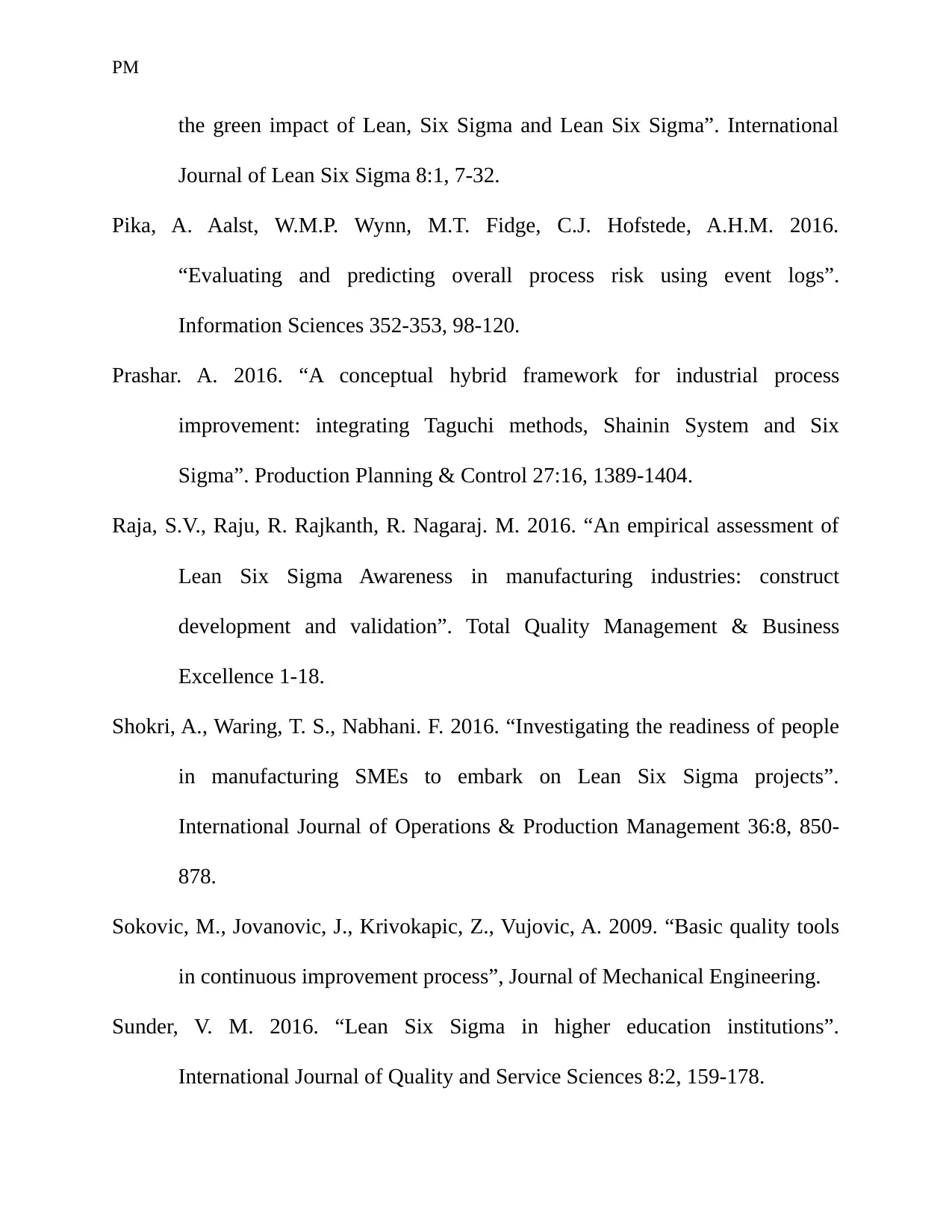
PM
the green impact of Lean, Six Sigma and Lean Six Sigma”. International
Journal of Lean Six Sigma 8:1, 7-32.
Pika, A. Aalst, W.M.P. Wynn, M.T. Fidge, C.J. Hofstede, A.H.M. 2016.
“Evaluating and predicting overall process risk using event logs”.
Information Sciences 352-353, 98-120.
Prashar. A. 2016. “A conceptual hybrid framework for industrial process
improvement: integrating Taguchi methods, Shainin System and Six
Sigma”. Production Planning & Control 27:16, 1389-1404.
Raja, S.V., Raju, R. Rajkanth, R. Nagaraj. M. 2016. “An empirical assessment of
Lean Six Sigma Awareness in manufacturing industries: construct
development and validation”. Total Quality Management & Business
Excellence 1-18.
Shokri, A., Waring, T. S., Nabhani. F. 2016. “Investigating the readiness of people
in manufacturing SMEs to embark on Lean Six Sigma projects”.
International Journal of Operations & Production Management 36:8, 850-
878.
Sokovic, M., Jovanovic, J., Krivokapic, Z., Vujovic, A. 2009. “Basic quality tools
in continuous improvement process”, Journal of Mechanical Engineering.
Sunder, V. M. 2016. “Lean Six Sigma in higher education institutions”.
International Journal of Quality and Service Sciences 8:2, 159-178.
the green impact of Lean, Six Sigma and Lean Six Sigma”. International
Journal of Lean Six Sigma 8:1, 7-32.
Pika, A. Aalst, W.M.P. Wynn, M.T. Fidge, C.J. Hofstede, A.H.M. 2016.
“Evaluating and predicting overall process risk using event logs”.
Information Sciences 352-353, 98-120.
Prashar. A. 2016. “A conceptual hybrid framework for industrial process
improvement: integrating Taguchi methods, Shainin System and Six
Sigma”. Production Planning & Control 27:16, 1389-1404.
Raja, S.V., Raju, R. Rajkanth, R. Nagaraj. M. 2016. “An empirical assessment of
Lean Six Sigma Awareness in manufacturing industries: construct
development and validation”. Total Quality Management & Business
Excellence 1-18.
Shokri, A., Waring, T. S., Nabhani. F. 2016. “Investigating the readiness of people
in manufacturing SMEs to embark on Lean Six Sigma projects”.
International Journal of Operations & Production Management 36:8, 850-
878.
Sokovic, M., Jovanovic, J., Krivokapic, Z., Vujovic, A. 2009. “Basic quality tools
in continuous improvement process”, Journal of Mechanical Engineering.
Sunder, V. M. 2016. “Lean Six Sigma in higher education institutions”.
International Journal of Quality and Service Sciences 8:2, 159-178.
Paraphrase This Document
Need a fresh take? Get an instant paraphrase of this document with our AI Paraphraser
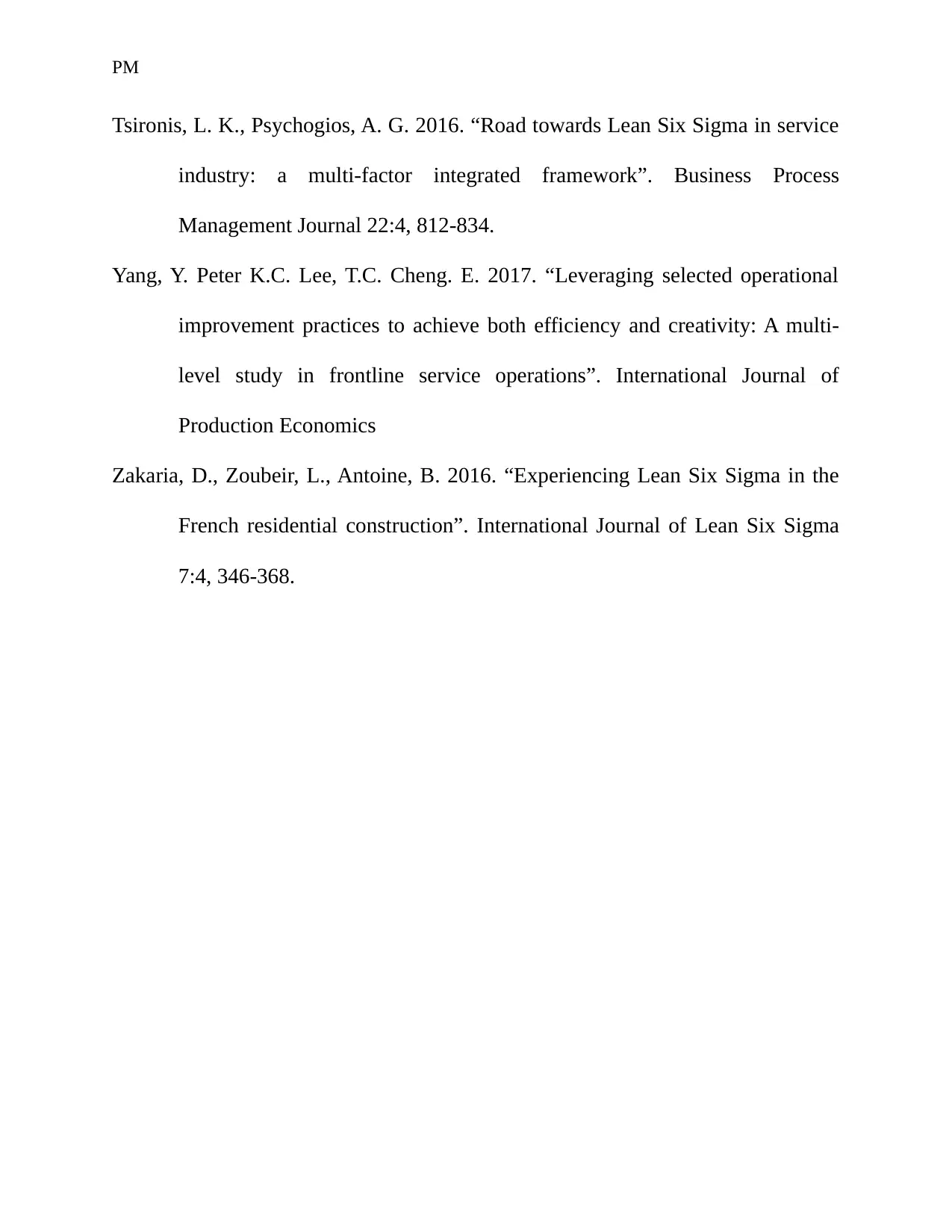
PM
Tsironis, L. K., Psychogios, A. G. 2016. “Road towards Lean Six Sigma in service
industry: a multi-factor integrated framework”. Business Process
Management Journal 22:4, 812-834.
Yang, Y. Peter K.C. Lee, T.C. Cheng. E. 2017. “Leveraging selected operational
improvement practices to achieve both efficiency and creativity: A multi-
level study in frontline service operations”. International Journal of
Production Economics
Zakaria, D., Zoubeir, L., Antoine, B. 2016. “Experiencing Lean Six Sigma in the
French residential construction”. International Journal of Lean Six Sigma
7:4, 346-368.
Tsironis, L. K., Psychogios, A. G. 2016. “Road towards Lean Six Sigma in service
industry: a multi-factor integrated framework”. Business Process
Management Journal 22:4, 812-834.
Yang, Y. Peter K.C. Lee, T.C. Cheng. E. 2017. “Leveraging selected operational
improvement practices to achieve both efficiency and creativity: A multi-
level study in frontline service operations”. International Journal of
Production Economics
Zakaria, D., Zoubeir, L., Antoine, B. 2016. “Experiencing Lean Six Sigma in the
French residential construction”. International Journal of Lean Six Sigma
7:4, 346-368.
1 out of 20
Related Documents
Your All-in-One AI-Powered Toolkit for Academic Success.
+13062052269
info@desklib.com
Available 24*7 on WhatsApp / Email
![[object Object]](/_next/static/media/star-bottom.7253800d.svg)
Unlock your academic potential
© 2024 | Zucol Services PVT LTD | All rights reserved.





